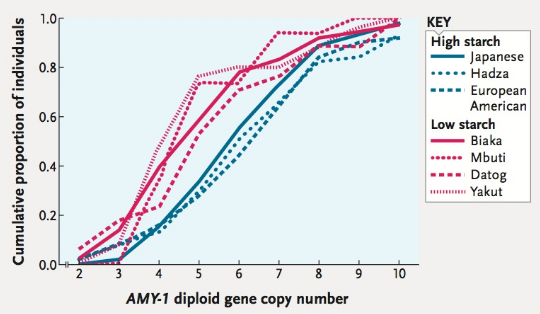
Concept explainers
The human AMY-1 gene encodes salivary amylase, an enzyme that breaks down starch. The number of copies of this gene varies, and people who have more copies generally make more of the enzyme. In addition, the average number of AMY-1 copies differs among cultural groups.
George Perry and his colleagues hypothesized that duplications of the AMY-1 gene would confer a selective advantage in cultures in which starch is a large part of the diet. To test this hypothesis, the scientists compared the number of copies of the AMY-1 gene among members of seven cultural groups that differed in their traditional diets. The Figure shows their results.
Starchy tubers are a mainstay of Hadza hunter-gatherers in Africa, whereas fishing sustains Siberia’s Yakut. Almost 60% of Yakut had fewer than 5 copies of the AMY-1 gene. What percentage of the Hadza had fewer than 5 copies?

FIGURENumber of copies of the AMY-1 gene among members of cultures with traditional high-starch or low-starch diets.
Source: G. Perry et al. 2007. Diet and the evolution of human amylase gene copy number variation. Nature Genetics 39:1256–1260.
Trending nowThis is a popular solution!

Chapter 47 Solutions
Biology: The Dynamic Science (MindTap Course List)
- A scientist studies the production of a key digestive enzyme in silk moths. The moths have one gene for this enzyme, and the scientist extracts mRNA transcribed from this gene as well as protein translated from it. The gene has three introns in its sequence. If the same scientist extracts the DNA for this gene and finds that it becomes methylated over the life of the organism, how will digestion change over time? A. It will occur at lower pH. B. It will rely more on this enzyme over time. C. It will use methylated copies of the enzyme. D. It will involve a lesser quantity of this enzyme over time.arrow_forwardScientists and nutritionists have long suspected that high-fructose corn syrup, used to sweeten soft drinks, is one of the causes of childhood obesity. In a recent study, at the University of Cincinnati, researchers found that mice that drank water with added fructose ate less solid food, gained more weight, and put on 90% more body fat than mice that drank only water. Scientists concluded that fructose may cause the body to store fat. What is the control used in this experiment?arrow_forwardWhat is the basis of saying that a particular nutrient is essential? Why are some nutrients considered nonessential? How do you correct amino acid disproportion among poultry and swine?arrow_forward
- The small intestine breaks down sugars other than maltose. Lactose, for example is broken down into glucose and galactose by an enzyme called lactase. The monosaccharides can then be absorbed by the small intestine. If an individual does not produce enough lactase, the lactose moves into the colon and is used by bacteria to make carbon dioxide and other gasses. Hypothesize how the gut bacteria are able to make CO2 from lactose. (2-3 sentences)arrow_forwardWhy did 40% of the human population evolve to tolerate lactose? Lactose tolerance allows people to enjoy a wide variety of food, including milk, butter, ice cream, and cheese. People who have an intolerance experience physical pain, so a tolerance evolved to avoid that. Babies rely on milk to survive, so they need to be able to tolerate lactose. Within cultures that rely on milk-producing animals, individuals who tolerated lactose had a survival advantage.arrow_forwardIf a zoo animal eating ample food shows signs of malnutrition, how might a researcher determine which nutrient is lacking in its diet?arrow_forward
- Discuss the various biological steps that will take place in your body to extract the necessary nutrients like amino acids, glucose, and fatty acids from the food and make them available to the body cells.arrow_forwardWhy are cattle able to survive, grow, and reproduce on a plant diet which does not contain most of the essential amino acids required for their health? Select one: a. Their saliva has cellulase and can therefore digest cellulose present in plant cell walls b. Like rabbits, cattle can re-ingest their feces c. Bacteria in their rumen synthesize essential amino acids from digested plant material d. They are unique in that they can synthesize all essential amino acids in their liver from a variety of metabolic precursors e. They are autotrophsarrow_forwardThe food label in Figure 11.28 lists the nutrients and other substances in a package of ready-to-eat macaroni and cheese. Based on your reading in this chapter, how would you rate this products healthiness in terms of fats and carbohydrates? Figure 11.28 Food labels are useful health tools. Information on a food label can be used to ensure that you get the nutrients you need without exceeding recommended limits on less healthy substances such as salt, sugar, and trans fats. At present, the USDA is considering major revisions to food labels. The proposed changes include showing realistic serving sizes and sugars added by the manufacturer, and printing the calorie content per serving in larger, bolder type so that it is easier for consumers to make informed choices about purchases of prepared foods. (Left: USDA, US Department of Agriculture; Right: FoodCollection/SuperStock)arrow_forward
- What are some metabolic adaptations (for example, lactose tolerance in groups derived from herders) found in modern-day humans and Neanderthal genetics?arrow_forwardUsing a research to defend your position,can we draw a straight line and suggest only one specific choice of diet or should we look into combined diet solutions?arrow_forwardExplain why wastage of essential amino acids can occur and how eating two foods simultaneously can prevent wastage.arrow_forward
 Biology: The Dynamic Science (MindTap Course List)BiologyISBN:9781305389892Author:Peter J. Russell, Paul E. Hertz, Beverly McMillanPublisher:Cengage Learning
Biology: The Dynamic Science (MindTap Course List)BiologyISBN:9781305389892Author:Peter J. Russell, Paul E. Hertz, Beverly McMillanPublisher:Cengage Learning Human Biology (MindTap Course List)BiologyISBN:9781305112100Author:Cecie Starr, Beverly McMillanPublisher:Cengage Learning
Human Biology (MindTap Course List)BiologyISBN:9781305112100Author:Cecie Starr, Beverly McMillanPublisher:Cengage Learning


